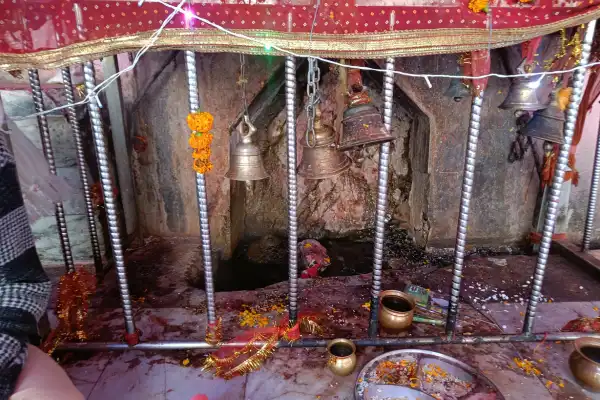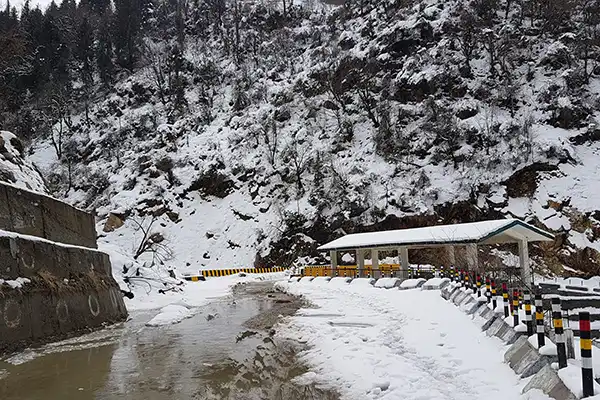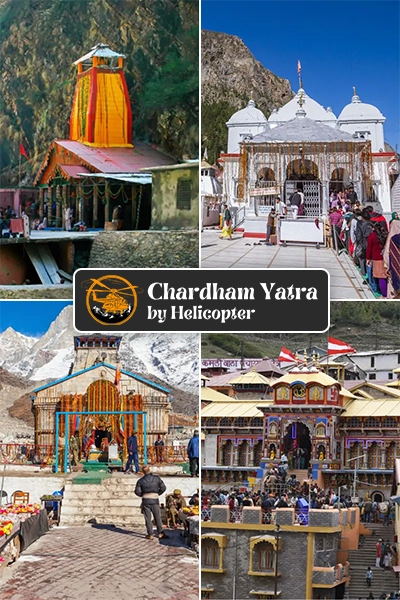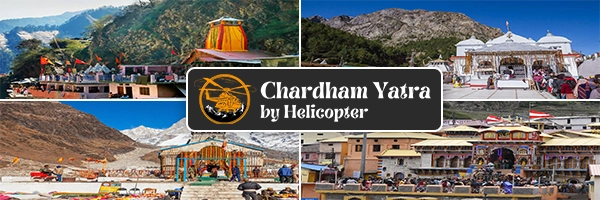The sacred Yamuna River is believed to have started from Yamunotri, which is placed high in the Garhwal Himalayas at a height of around 3,293 metres. It is one of India’s Char Dham pilgrimage sites and a peaceful mountain retreat for families and groups. Every year from April/May (Akshaya Tritiya) until late October or Diwali, the temple opens to devotees. This guide lists the Things to Do in Yamunotri for families and pilgrims. Each point gives clear, step‑by‑step detail.
1. Start Your Day with Darshan at Yamunotri Temple
Begin your day early at the Yamunotri Temple, dedicated to Goddess Yamuna. The temple opens at 7:30 AM for morning darshan and closes at noon; it reopens in the afternoon till 8 PM.
The idol is made of black marble or silver and decorated with garlands by the Uniyal priest family from nearby Kharsali. Worship at Divya Shila, the slab of divine light set near the hot spring, before entering the shrine.
Inside, chant simple mantras or sing hymns. The temple sits against the backdrop of Bandarpunch peak, offering calm and lasting memories.This darshan is seen as a spiritual experience, where mountain views are admired, fresh air is felt, and other pilgrims are met. Modest clothes should be worn and footwear should be removed. Photography is usually not allowed, so rules must be respected. After darshan, refresh with local tea or snacks from small vendors near the temple. Then continue with other Things to Do in Yamunotri.
2. Take a Holy Dip in Surya Kund
Right behind the Yamunotri Temple lies Surya Kund, a boiling hot spring believed sacred and medicinal. The name relates to Surya, the Sun and in local belief its heat cures illness and purifies the soul. Devotees dip muslin‑wrapped rice and potatoes into the spring’s boiling water (≈88 °C) to cook prasad. Once cooked (in 5–10 minutes), the food becomes sanctified and is offered at Divya Shila and then taken into the temple as prasad.
Many people even take a short hand‑dip in the spring carefully to avoid burns believing it cleanses sins. The mix of worship and natural warmth gives spiritual uplift and physical comfort.
While waiting, enjoy views of the temple, fresh mountain air, mountain streams and chanting. Locals offer instructions and tools like cloth and sticks. Make sure to carry muslin cloth and food items. After the dip, rinse in cool water from the nearby Yamuna River. This fresh water balances the heat. Then head across to Divya Shila or rest by the riverbank. This ritual is among the best Things to Do in Yamunotri for families.
3. Cook Prasad in the Natural Hot Springs
At Surya Kund and nearby Gauri Kund, you can cook rice and vegetables as prasad. At Surya Kund the water is boiling. At Gauri Kund it is warm enough for bathing or cooking mild prasad.
Tie raw rice or potatoes in muslin cloth, then dip in the hot water. It takes about 5–10 minutes to cook. Locals help place the cloth in spring and retrieve it carefully after cooking. The cooked food is sacred and shared or taken home.
This sacred cooking is unique, blending devotion, nature, and tradition. It also gives material memories prasad lovingly wrapped. Children often enjoy watching the boiling springs and learning the local ritual. Safety tip: don’t touch the water directly without a tool. Maintain distance and listen to guides. Surya Kund water is nearly at boiling; Gauri Kund is gentler. Respect religious practice and use only permitted springs.
After cooking, bless the prasad at Divya Shila, then head to temple darshan holding your sacred food. A vivid memory of pilgrimage and nature is created by this. People always remember this way of cooking prasad. When you do it like this, it feels special. Many say, ‘This is the best thing we did in Yamunotri.’ It’s not just fun, it’s something that families keep doing every year. Everyone calls it a sweet tradition. You cook, you pray, and you smile. That’s why it stays in your heart.
4. Enjoy the Scenic Trek to Yamunotri Dham
From Janki Chatti, pilgrims trek about 6 km uphill to the temple. From Hanuman Chatti, a trek of 13 km is covered. When you walk on both roads, you see big waterfalls, green valleys, and tall trees like pine and oak. The Himalayan views are also seen all around. You will love what your eyes see. Every step gives you something to smile about. Ponies and palanquins are available from both base camps. But walking is recommended to see nature. The route takes 2–6 hours depending on pace.
Along the way, rest at Dhaba or shaded spots. Refresh with tea, biscuits, and fruit. The trail includes small wooden bridges, streams and prayer flags. Alpine air and mountain views boost energy. Mid‑way, you’ll reach Surya Kund and Divya Shila, both sacred stops. You can pause, cook prasad, dip your hands, then continue.
The trek reveals the Yamuna River flowing alongside. At higher elevations you see snow patches near Bandarpunch peaks. At higher altitudes oxygen drops; breathe slowly. The walk is spiritual, healthy and scenic. It builds anticipation for temple darshan. Families can pause often; senior members can ride ponies. Carry water and light snacks. This scenic walk blends fitness, faith, and nature. Include it in your list of Things to Do in Yamunotri for both spiritual and natural fulfillment.
5. Visit Divya Shila – The Sacred Rock
Before entering the temple, visit Divya Shila, a sacred rock pillar near Surya Kund. Known as the “slab of divine light,” pilgrims worship it before temple entry. Standing before the rock, devotees rinse their prasad or food items, tie offerings and whisper prayers. It feels like a spiritual checkpoint—a connection point before approaching Chief Idol of Goddess Yamuna.
It is not legally mandatory but is encouraged by temple tradition. Many families pause there for a moment of silent prayer. Some tie a red thread or small cloth as vow offerings.
The rock is set close to hot springs, so you feel warmth and energy. Locals may explain rituals and help with offerings. The place is well kept and clean. After worshipping Divya Shila, head into the main temple. Many pilgrims say their prayers feel deeper afterward. For visitors, this is a simple, meaningful act quiet, respectful and reflective. Visiting and offering at Divya Shila is one of those gentle Things to Do in Yamunotri that stays in memory.

6. Explore the Hanuman Chatti Village
Hanuman Chatti, 13 km from Yamunotri Temple, is the larger base camp for pilgrims. Located at ~2,400 m, it lies at the confluence of Hanuman Ganga and Yamuna rivers. The village is peaceful, with guest houses, shops, eateries, and small temples (including Hanuman Temple). Ponies and palanquins are rented here. Families enjoy tea stalls, modest shopping for snacks or woollen clothes.
Small waterfalls and viewpoints are reached through nearby walking trails. Green valleys and mountain slopes can be admired along the way. Few stalls sell local honey, dried fruit and snacks. The atmosphere is calm and suited to rest. Pilgrims often stay overnight in Hanuman Chatti before doing the trek the next day. The village offers simple meal halls with nutritious meals dal, rice, sabzi, chapati, tea. Talking to villagers, pilgrims learn about local Kanwari history, route conditions, and weather. Many are supportive and know pilgrimage stories.
Spending time here gives insight into local life. You witness Himalayan hospitality and learn about traditions. Visiting Hanuman Chatti is a peaceful stop on your Things to Do in Yamunotri list. It balances rest, culture and nature.
7. Stop by Janki Chatti’s Thermal Springs
Janki Chatti, at ~2,650 m and about 7 km before Yamunotri Temple, hosts famous thermal hot springs. Pilgrims often pause here to soak sore feet before trekking further. The springs are warm and soothing. Some people dip their hands or legs. The water is believed to be good for joints and circulation. A short soak refreshes tired pilgrims before starting the 6 km trek to Yamunotri.
Near the springs, small tea stalls offer snacks and hot beverages. Locals show where to soak safely and remind them to avoid full submersion. Ponies/palanquins are rented here for the steep trek onwards. Guides highlight conditions ahead. Beyond spiritual healing from Surya Kund, Janki Chatti springs offer physical refreshment and a chance to relax in nature. A brief visit to these springs is ideal for families and pilgrims. It balances the trek with quiet natural warmth. This stop is one of the thoughtful Things to Do in Yamunotri, especially before the final ascent.

8. Enjoy the Calmness of the Yamuna River
The clear Yamuna River flows through the valley from its glacier source near Yamunotri Glacier (Champasar Glacier) at ~4,421 m Along the trek, you walk beside the river in parts. The cool mountain stream is peaceful. Many pilgrims pause to dip their hands, wash their face, or pray quietly. The riverbanks have smooth stones and small patches of grass. Families often sit for a few minutes to reflect or enjoy a simple snack. The sound of water and birds adds calm.
Up at Yamunotri, the infant Yamuna flows near the temple. You may see clear water splashing over rock, cold and pure. During monsoon or spring melt, the flows can rise. Walk carefully near the edges. Avoid deep parts. Respect warnings and stay safe. Enjoying the Yamuna’s calm is a spiritual feeling of divine presence in water, air, mountain mist and birdsong. No crowds, just nature and devotion. This quiet connection with the river is a natural thing to do in Yamunotri that stays with you long after the trip.
9. Connect with Locals and Try Local Food
In villages like Hanuman Chatti, Janki Chatti and Kharsali, locals offer simple meals and share stories. You can try aloo‑puris, pakoras, dal, rice, local tea and sweet rice pudding. Many home‑run stalls cook wholesome food fresh for devotees. Ingredients come from nearby hamlets, offering local taste. The food is light, vegetarian and filling. Farmers and shopkeepers welcome questions. Pilgrims learn about local customs, festival dates (like idols shifting to Kharsali in Diwali), and local names for routes or springs.
It’s a personal connection. Dark nights in the villages bring campfire singing and prayer songs in a few guest houses. Some share regional folk tales about Yamunotri Glacier and Bandarpunch peaks. Buying ginger‑honey tea, mountain fruits or grass‑weave shawls helps support villagers. You feel part of a pilgrimage instead of just visiting. This cultural contact is a key thing to do in Yamunotri. It broadens your experience beyond temple and trek.
10. Take Back Souvenirs and Herbal Medicines
Souvenirs like brass lamps, prayer flags, woollen caps, mountain honey, herbal teas, herbal oils, and simple mala (prayer beads) are sold at local stalls in Kharsali, Janki, and Hanuman Chatti. Herbal items may include local tubers, mint tea, tulsi drops, mountain honey, ginger‑herb mixes. These are natural and made by local women’s groups. They claim benefits for digestion or colds.
Souvenirs like small brass diya lamps with Yamuna painting, prayer flags, or woollen shawls make meaningful gifts. They keep the memory of pilgrimage alive. Avoid buying plastic or imported trinkets. Opt for local goods that benefit villagers. Keep cash ready in small notes. Taking these souvenirs and herbs home is a tangible reminder of spiritual Things to Do in Yamunotri. They connect you back to mountain culture and tradition.
Final Thoughts – Yamunotri Is More Than Just a Pilgrimage
You know what’s special about Yamunotri? It’s not just about darshan. People there love everything: the river, the hot water springs, even the cold breeze that touches your face. You’ll see prasad being cooked in that hot spring water. It smells so good, you feel hungry even if you’re not. Some people quietly walk on the hilly paths. Some just sit and talk to the locals. Nothing feels rushed. Everything just flows. And maybe that’s the magic God, nature, people all sitting together like old friends.
The Things to Do in Yamunotri above offer both devotion and natural beauty in simple, clear ways families and pilgrims will love. The site opens April/May and closes by Diwali. Plan your trip within this window for your Chardham yatra by helicopter. For travellers, the journey is affordable, local‑language guided, and deeply meaningful. It cleanses the mind and shows how faith and nature live together in the Himalayas.
FAQ
Q.1 When should we visit Yamunotri?
The temple is usually opened near the end of April, mostly on Akshaya Tritiya. In 2025, it will be opened on April 30. It is then closed around Diwali. During the rainy months like July and August, and also in winter from November to April, the place is kept closed. So, those times are not chosen for visiting.
Q.2 How far is Yamunotri from Janki Chatti or Hanuman Chatti?
It is about 6 km from Janki Chatti, and about 13 km from Hanuman Chatti. Both are base‑camp villages for the trek
Q.3 Is cooking prasad in the hot spring allowed?
Yes. At Surya Kund, pilgrims cook rice or potatoes in muslin cloth using boiling hot water and then offer them at Divya Shila and the temple. It is a rooted tradition.
Q.4 What is Divya Shila and its importance?
Divya Shila is a sacred rock near Surya Kund. Pilgrims worship it before entering the temple. It is believed to have divine energy and prepare the mind for darshan
Q.5 Can elderly or children do the trek?
Yes. Ponies and palanquins are available. The trail is gradual and boats up past rivers and forest. People walk at their own pace. Local support is readily available in villages.



